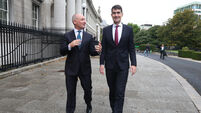Why is our 'war on drugs' mired in contradictions?

While the Government has moved with great speed to rectify a gaping hole in our drug laws following a landmark ruling in the Court of Appeal, it has not tackled a wider, and more fundamental, issue raised in the same judgement.
As has been widely reported, Mr Justice Gerard Hogan said that the legal mechanism used by the Government to add new substances to a list of controlled drugs was unconstitutional.
He, along with his two fellow judges, found that this power was one that must, under the Constitution, be carried out by the Oireachtas, as it was a matter of policy.
The result of the appeal court’s decision was that all the drugs added to the list through regulations under Section 2 (2) of the Misuse of Drugs Act 1977 were not illegal. This led to the Government rushing through emergency legislation to rectify the problem, whereby the Oireachtas voted to make the drugs illegal.
But a second issue highlighted in the judgment was the absence of reasons in the 1977 Act, either in Section 2 (2) or elsewhere, which would set out how, and on what basis, new drugs would be added to the schedule.
Mr Justice Hogan said that for the Government to have this power delegated to it by the Oireachtas, the original legislation must contain “clear principles and policies”.
He examined the act and found it did not contain these provisions, providing a further reason why the Government’s actions were unconstitutional.
Because the Oireachtas has voted to make these drugs illegal, the second issue of there being guiding principles do not apply, as the Government is not making the decision.
But it does raise the issue of the Oireachtas itself gathering, discussing, and laying out the rationale for banning drugs — and which drugs to ban.
Mr Justice Hogan said there was nothing in Section 2(2) which provided the necessary principles and policies.
He said the long title — the broad descriptions and purpose of the act — did provide some greater guidance. This stated that the purpose was to “prevent the misuse of certain dangerous or otherwise harmful drugs”.
Here, the judge asked a series of fundamental questions:
“One may immediately ask: how is it to be determined which of these dangerous or harmful drugs to be controlled and which are not?
“How can it be determined which drugs are “dangerous”?
“Again, one might ask: Dangerous to whom? Is this standard to be measured by reference to the general public? Or would it suffice that the drug in ques- tion would be dangerous if consumed or used by certain sectors of society such as children or young adults?
“By what standards are the questions of whether particular drugs are “harmful” and liable to be “misused” to be assessed and determined?”
Mr Justice Hogan said that “virtually every drug” is potentially harmful and liable to be misused. He asked: “What levels of ‘harm’ and ‘misuse’ need to be established before a drug could be added to the schedule of controlled substances?
“Could a particular drug be properly made the subject of an order under Section 2 (2) of the 1977 Act where there was a respectable body of scientific and medical evidence to the effect that the drug in question should not be controlled or that its beneficial properties strongly outweighed the risk of abuse by a minority of patients?”
He cited the judgement of the High Court in the case he and his fellow judges were now deliberating on in the Court of Appeal. He said the High Court had stated that the rationale behind the principles and policy test was that the legislative provision in question “must be sufficiently clear to allow a litigant to effectively challenge by way of judicial review”.
Mr Justice Hogan asked would it be open to the Government to ban other types of drugs which were in everyday use and which are potentially both harmful and liable to be misused?
“Alcohol and tobacco are the most common cases in point,” he said. “Alcohol is a major factor in range of serious anti-social activities, including road traffic fatalities and accidents, domestic violence, and other serious crimes...
“Alcohol is addictive and the abuse of alcohol in Irish society is regrettably so prevalent that it presents major public health challenges, of which alcoholism and cirrhosis of the liver are among only the most prominent.
“Tobacco consumption is highly addictive and greatly increases the risk of lung cancer, heart disease, and a range of other serious illnesses. On any view, both drugs are harmful and are liable to be misused.”
But nowhere in the Misuse of Drugs Act is there an analysis of how certain drugs reach this classification and on what basis — and how certain drugs (such as alcohol and tobacco) do not.
The emergency legislation gives no insight into this, as it was merely meant to rectify the particular illegality identified by the Court of Appeal. There are no details on how “harm” or “dangerous” or “misuse” are to be determined.
These issues were touched on in the Seanad debate of the emergency law on Wednesday. Law professor Ivana Bacik said a wider debate was needed on the issue of controlling drugs.
“We need to examine, in a considered fashion, other countries which have adopted different approaches to the regulation of what we call controlled drugs,” she said. “Generally speaking, billions have been spent to prevent drug addiction and the drugs trade, but it is not working. We have to look at the whole drug situation and have a national conversation to see where we go in the future.”
Independent senator James Heffernan suggested the Government could pilot a scheme to allow recreational drugs be provided “in a responsible manner to certain people”.
He said: “While all these drugs remain illegal, the profits from their sale and supply go to criminal organisations and spawn every sort of social ill that one can imagine.”
Despite pushing through emergency laws to ban a long list of substances, Health Minister Leo Varadkar indicated a preference for dealing with drugs from a health point of view.
“A number of senators called for a more health-focused approach rather than a criminal justice one to deal with the drugs crisis,” he said. “My own instincts are in that direction too.”
What the minister means by that is not clear.
In giving his judgment, Mr Justice Hogan has done a wider public policy service. He has highlighted a glaring absence of rationale in how substances are banned or, indeed, not banned.
And the country’s key legislation on this area, the Misuse of Drugs Act, is, still, largely silent on the matter.
More analysis and comment here















